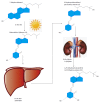Is there a relationship between vitamin D with insulin resistance and diabetes mellitus?
- PMID: 26240702
- PMCID: PMC4515445
- DOI: 10.4239/wjd.v6.i8.1057
Is there a relationship between vitamin D with insulin resistance and diabetes mellitus?
Abstract
Available data suggest a possible link between abnormal vitamin D level and abnormal glucose homeostasis, two of the most common chronic medical conditions. Both conditions are associated with inflammation, and the exact mechanism for role of either on the other is not well clear. Literature investigating the link between vitamin D and either pre-diabetic states or diabetes is reviewed. Vitamin D deficiency is detrimental to insulin synthesis and secretion in animal and human studies. In humans, it has been shown by majority of observational studies, that vitamin D is positively correlated with insulin sensitivity and its role is mediated both by direct mechanism through the availability of vitamin D receptors in several tissues and indirectly through the changes in calcium levels. Large number of, but not all, variable samples cross sectional human trials have demonstrated an inverse relation between vitamin D status and impaired glucose tolerance, insulin resistance or diabetes. To compliment this conclusively, evidence from intervention studies is critically warranted before we can frankly state that vitamin D plays a role in diabetes prevention or treatment. Absence of both sizable prospective observational trials utilizing 25(OH)D as the main variable and the non-availability of randomized studies specifically designed to assess the effects of vitamin D on pre-diabetes and diabetes states, are the main obstacles to draw solid and conclusive relationships.
Keywords: Insulin resistance; Type 2 diabetes; Vitamin D.
Figures

References
-
- International Diabetes Federation. IDF Diabetes Atlas, 6th ed. Brussels, Belgium: International Diabetes Federation; 2013. Available from: http://www.idf.org/diabetesatlas.
-
- James WP. 22nd Marabou Symposium: the changing faces of vitamin D. Nutr Rev. 2008;66:286–290. - PubMed
-
- Bischoff-Ferrari HA, Willett WC, Wong JB, Stuck AE, Staehelin HB, Orav EJ, Thoma A, Kiel DP, Henschkowski J. Prevention of nonvertebral fractures with oral vitamin D and dose dependency: a meta-analysis of randomized controlled trials. Arch Intern Med. 2009;169:551–561. - PubMed
Publication types
LinkOut - more resources
Full Text Sources
Other Literature Sources

